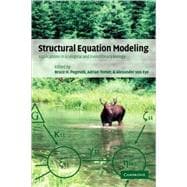
Note: Supplemental materials are not guaranteed with Rental or Used book purchases.
Purchase Benefits
Looking to rent a book? Rent Structural Equation Modeling: Applications in Ecological and Evolutionary Biology [ISBN: 9780521104029] for the semester, quarter, and short term or search our site for other textbooks by Edited by Bruce H. Pugesek , Adrian Tomer , Alexander von Eye. Renting a textbook can save you up to 90% from the cost of buying.
| Theory | |
| Structural equation modelling: an introduction | |
| Concepts of structural equation modelling in biological research | |
| Modelling a complex conceptual theory of population change in the Shiras moose: history and recasting as a structural equation model | |
| A short history of structural equation models | |
| Guidelines for the implementation and publication of structural equation models | |
| Applications | |
| Modelling intra-individual variability and change in bio-behavioural developmental processes | |
| Examining the relationship between environmental variables and ordination axes using latent variables and structural equation modelling | |
| From biological hypotheses to structural equation models: the imperfection of causal translation | |
| Analysing dynamic systems: a comparison of structural equation modelling and system dynamics modelling | |
| Estimating analysis of variance models as structural equation models | |
| Comparing groups using structural equations | |
| Modelling means in latent variable models of natural selection | |
| Modeling manifest variables in longitudinal designs - a two-stage approach | |
| Computing | |
| A comparison of the SEM software packages Amos, EQS and LISREL | |
| Index | |
| Table of Contents provided by Publisher. All Rights Reserved. |
The New copy of this book will include any supplemental materials advertised. Please check the title of the book to determine if it should include any access cards, study guides, lab manuals, CDs, etc.
The Used, Rental and eBook copies of this book are not guaranteed to include any supplemental materials. Typically, only the book itself is included. This is true even if the title states it includes any access cards, study guides, lab manuals, CDs, etc.